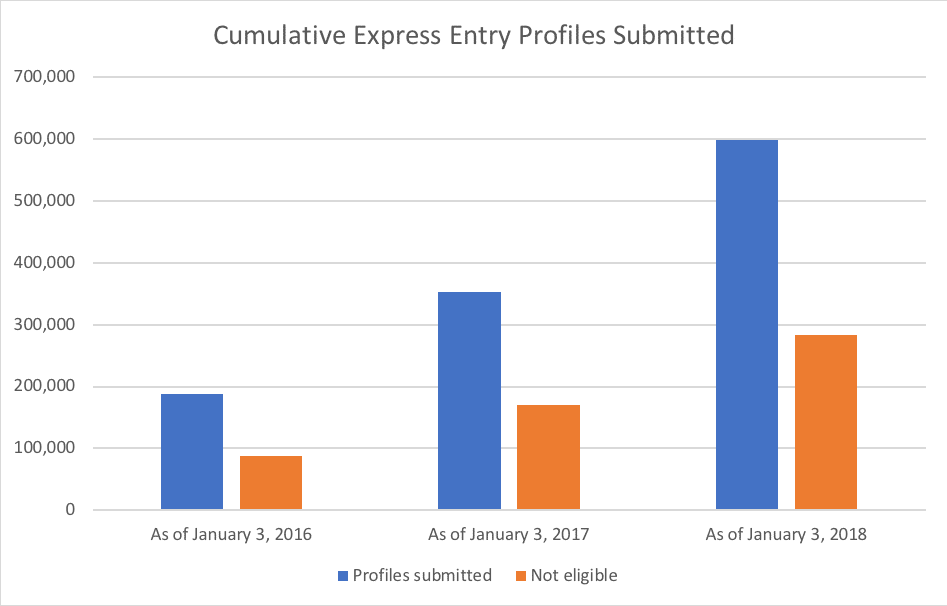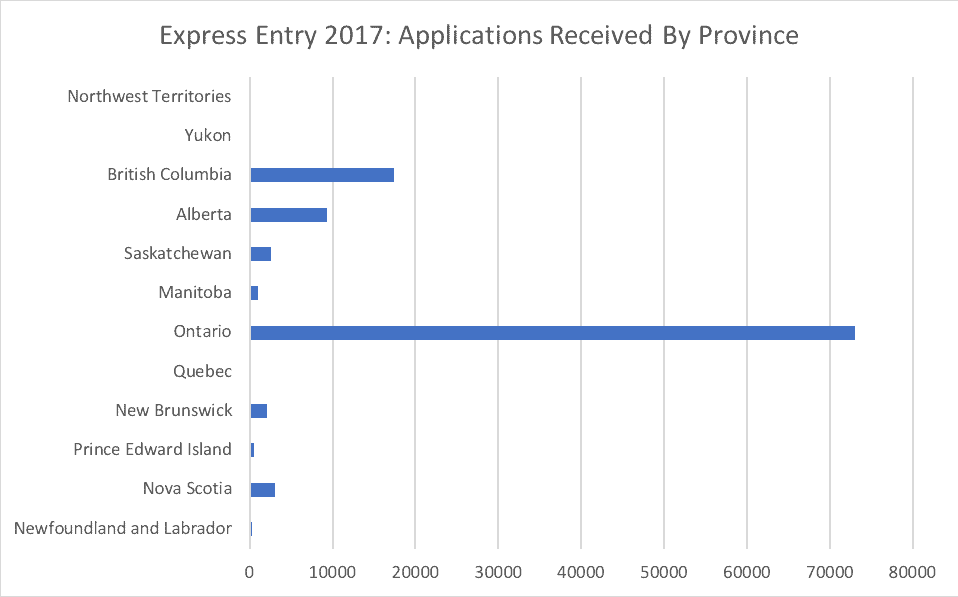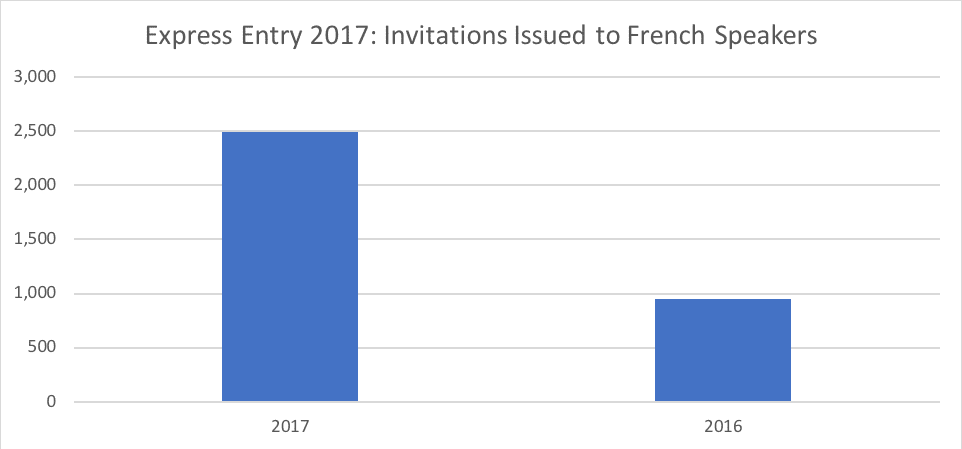 June 1, 2018 – A new federal government report reveals the data behind what was a record-breaking year for the Canada Express Entry System in 2017.
June 1, 2018 – A new federal government report reveals the data behind what was a record-breaking year for the Canada Express Entry System in 2017.
History was made on almost every statistic associated with the program. This includes Invitations to Apply, minimum Comprehensive Ranking System scores and largest individual Express Entry draws.
Some of the key statistics include:
- Total ITAs for the year almost tripled to more than 86,000 from less than 34,000 in 2016
- Record lowest CRS score in the history of any draw at 413
- Highest number of invitations issued in a single draw at 3,923
- Total number of profiles received since Express Entry began rose to 598,507
- Federal Skilled Worker Program invitations issued rose from 8,332 in 2016 to 41,364
- Canadian Experience Class invitations issued rose from 15,102 in 2016 to 35,020
- First program-specific draws held for Federal Skilled Trades Programand Provincial Nomination Program
- 109,497 applications received in 2017, resulting in 96,182 approved applications, 93,569 visas issued and 65,401 admissions

Express Entry by Immigration Program
The Federal Skilled Worker and Canadian Experience Class dominated the statistics when the invitations issued are broken down by program.
The FSW by itself accounted for approaching half of all invitations in 2017, with 41,364 candidates invited to apply for the program. Compared to the 8,332 invites issued through Express Entryfor the FSW in 2016, this represents a 400 per cent increase. The CEC increase was less dramatic, but still significant, with the program accounting for 35,020 invites in 2017, up from 15,102 in 2016. The nature of the two programs means they will attract candidates with high core human capital scores, making it no surprise they dominate the numbers.
Read More
2018 Express Entry First Quarter Review
Canada Immigration: 2017 Year in Review
2017 Express Entry 9-Month Review
2017 Express Entry 6-Month Review
2016 Express Entry Year-End report
Invitations to candidates with provincial nominations were a distant third in 2017, while there were less than 1,000 Federal Skilled Trades candidates receiving ITAs. Just one of these FST candidates was invited via a general Express Entry draw, indicating why IRCC conducted its first FST-only draws in 2017, inviting a total of 905 candidates. Skilled Trades candidates would have no chance of qualifying for an invitation if it was not for the program-specific draws, which have continued into 2018. This was a result of the reduction in points for a qualified job offer, introduced in November 2016. Skilled Trades job offers were generally worth 50 points following the changes, down from 600 point per-November 2016. IRCC said that PNP draws were conducted alongside FST draws in order to manage the numbers of candidates receiving a provincial nomination in the Express Entry Pool.

Express Entry 2017: Residence and Citizenship
Candidates already resident in Canada dominated the figures when broken down by residency, with more than 42,000 of those receiving invites already living here. This shows how important the Temporary Foreign Worker Program and International Mobility Program have become to Canada’s core annual immigration intake.
However, as a percentage of the total number of invites, the proportion going to candidate’s resident in Canada fell between 2016 and 2017. In 2016, 64 per cent of the total 33,782 invites went to Canadian residents. In 2017, that figure dropped to 49 per cent of the 86,022 invitations issued.

However, when looking at the invitations issued by citizenship, Indians strengthened their dominant position, accounting for 42 per cent of all invites in 2017, compared to 33 per cent in 2016. In 2017, 36,310 Indian citizens were invited through Express Entry. The second most prolific citizenship was Chinese, with just 7,466 invitations.

Express Entry 2017: Top Occupations
Changes to CRS points awarded for a qualified job offer in November 2016 had a significant impact on the primary jobs of immigration candidates, according to the Express Entry data for 2017.
The changes were made because IRCC felt too much importance had been placed on the job offer by awarding 600 points. By reducing the points available to 200 or 50, depending on the skill level of the position, the intention was to give more weight to core Express Entry human capital factors such as age, education, employment history and language ability.
In 2016, Cooks and Food Service Supervisors figured high on the list of top 10 occupations, but the 2017 top 10 tells a different story.
Information Systems Analysts and Consultants were top with more than 5,200 invitations, with Software Engineers second and Computer Programmers third. This fits with Canada’s strategy of using immigration to make up a technology talent shortage. Indeed, the entire top 10 for 2017 includes managerial and professional occupations aligned with shortages in the Canadian labour market. With Express Entry intended as a selection tool for skilled economic immigrants, the top 10 of 2017 better fits that profile than the top 10 of 2016.
Express Entry 2017: Invitations Issued by Occupation
| 1 | NOC2171 – Information systems analysts and consultants | 5,214 |
| 2 | NOC2173 – Software engineers | 4,782 |
| 3 | NOC2174 – Computer programmers and interactive media developers | 3,479 |
| 4 | NOC1111 – Financial auditors and accountants | 2,386 |
| 5 | NOC1241 – Administrative assistants | 1,969 |
| 6 | NOC1123 – Professional occupations in advertising, marketing and public relations | 1,884 |
| 7 | NOC4011 – University professors and lecturers | 1,830 |
| 8 | NOC1112 – Financial and investment analysts | 1,783 |
| 9 | NOC1122 – Professional occupations in business management consulting | 1,621 |
| 10 | NOC0124 – Advertising, marketing and public relations managers | 1,497 |
Express Entry 2017: Spike in Applications Received
Moving from invitations issued to applications received, 2017 was again a significantly more prolific year for Express Entry. The figures also show how important inventory is to the Express Entry system, with 109,497 applications received in 2017 against total invitations of 86,022. As such, many of the applications received in 2017 were a result of invitations already issued in 2016. IRCC began increasing the number of ITAs at the back end of 2016 to increase the size of the inventory in the Express Entry Pool. This continued in the first half of 2017, with numbers dropping in the second half of the year and into 2018 once the inventory was established.
The figures also show the healthy relationship between applications received, applications approved and visas issued. One of the key attributes of the Express Entry System is that candidates self-evaluate, meaning the calibre of candidate entering the pool is already higher. As such, when they eventually come to submitting applications, they are more likely to be successful. In 2017, 109,497 applications were received and 93,596 visas issued.

Express Entry 2017: Provincial Picture
The applications received by intended province of destination reveal exactly how dominant Ontario is when it comes to Express Entry. Out of 109,497 applications received in 2017, 72,993 of them stated Ontario as their province of destination, almost exactly two-thirds. The figures are a dramatic increase on 2016, when Ontario received 15,366 out of 42,712 applications, representing 36 per cent.
With Quebec not featuring in the figures as it manages its own immigration intake, the next province on the list is British Columbia, receiving 17,458 applications, or 16 per cent, in 2017, compared with 9,645, or 22.5 per cent, in 2016.

Impact of Additional Points
IRCC has altered CRS points in two waves since Express Entry began, the first in November 2016 and the second in June 2017.
The changes were intended to ensure the candidates accepted were better aligned to Canada’s economic needs, and more likely to integrate and achieve long-term economic success in Canada. As well as the changes, the numbers of points for a provincial nomination remained at 600, effectively guaranteeing an invitation in the next Express Entry draw.
November 2016 Changes
- Job offer
Points available drop to 200 or 50, depending on the skill level of the job. Senior managerial positions (National Occupational Classification 00) worth 200 points, while all other qualified job offers (NOC 0, A or B) worth 50 points.
- Canadian Education
New points introduced for Canadian education, as follows:
| Education Level | Number of Points |
| High school | 0 |
| One or two-year post secondary | 15 |
| Three-year post secondary, master’s, professional degree or doctorate | 30 |
June 2017 Changes
- More points for French language
Candidates score 15 additional points for a level 7 in listening, speaking, reading and writing in the Niveau de Competence Liguistique Canadiens (NLC) combined with an English score of 4 or below in the Canadian Language Benchmark (CLB).
Those points will rise to 30 if the French level 7 is combined with an English level 5 or above.
- New points for having a sibling in Canada
Candidates with a sibling living in Canada awarded 15 extra points.
Impact of Additional Points
| Additional point types | Invitations issued |
| Candidates without additional points | 43,285 |
| Candidates with additional points | |
| Provincial Nomination | 8,733 |
| Arranged Employment | 8,195 |
| Canadian Educational Credentials | 23,907 |
| French-Language Proficiency | 1,695 |
| Sibling in Canada | 3,781 |
Invitations Issued with Qualifying Job Offer
The 2017 figures show the vast majority of qualifying job offers under Express Entry were worth 50 points. Across the whole of the year, just 560 invitations were issued to candidates with job offers worth 200 points. While this number is low, it also establishes a 200-point job offer as an exclusive attribute when it comes to an Express Entry profile. Achieving a job offer remains the single most effective way of significantly boosting a candidate’s Express Entry profile.
| 50 pts | 200 pts |
| 7,635 | 560 |
Invitations Issued with Canadian Education Credential
A more significant number of invitations went to candidates with Canadian education credentials in 2017. This shows Express Entry has been successful in attracting more international students to Canada, which is a stated sim of the current federal Liberal government.
In 2017, 11,435 ITAs went to candidates with two-years of Canadian post-secondary education, while 12,472 invites went to those with three-year post secondary, master’s, professional degree or doctorate.
| 15 pts | 30 pts |
| 11,435 | 12,472 |
French Language Ability
Another of the federal government’s stated aims is to bring in more francophone permanent residents, and the 2017 Express Entry figures show they are having some success in doing that.
In 2017, 2,491 French-speaking candidates received invites, compared with only 945 in 2016. Some 452 ITA-receiving candidates scored 15 extra points for French language, with a further 1,243 scoring 30 extra points.

French Language Ability: Extra Points Scored
| 15 pts | 30 pts |
| 452 | 1,243 |
Conclusion
The Canada Express Entry System saw its most successful year in 2017. Invitations dramatically increased for the numbers of candidates to apply for permanent residence. Comprehensive Ranking System scores declined steadily during the year.
In 2017, Canada began using the express entry system for its entire economic immigrant intake. The inventory and backlog of older applications submitted directly to the Federal Skilled Worker, Federal Skilled Trades and Canadian Experience Class programs were completely eliminated.
Records were set for the lowest CRS score of 413 and the largest number of invitations, at 3,923, as IRCC looked to create an inventory of candidates from which applications were received.
Importantly, the year also showed the flexibility of the program, as immigration officials moved to make changes to how CRS points were awarded in order to ensure the right calibre of candidate was being invited.
This showed how the system can be modified as immigration policy changes, establishing it as the most cutting-edge immigration selection tool in the world.
Interested employers: Kindly contact us here to receive further information.
Interested candidates: Find out whether you qualify to Canada by completing our free on-line evaluation. We will provide you with our evaluation within 1-2 business days.
Read more news about Canada Immigration by clicking here.


